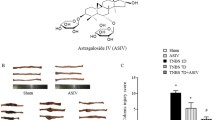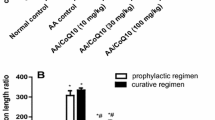Abstract
The aims of this study were to examine the ability of the antioxidant N-acetylcysteine (NAC) and mesalamine (5-ASA) alone and in combination to affect TNBS-induced colitis in rat. Three days following induction of TNBS colitis rats were randomized to receive daily intracolonic treatment with NAC, 5-ASA, and NAC plus 5-ASA for 5 or 8 days. At the end of the treatment period macroscopic and microscopic colonic injuries were scored. Myeloperoxidase (MPO) activity and cytokine gene expression were measured in colonic tissues. Results indicated that treatment with NAC plus 5-ASA caused a significantly greater reduction in colonic injury than either agent alone. Furthermore, combination therapy inhibited significantly MPO activity and inflammatory cytokine gene expression in the distal colon of TNBS-treated animals. The beneficial effects of NAC plus 5-ASA on reduction of colonic injury and promotion of healing were most evident after 8 days of treatment.
Similar content being viewed by others
References
Konstantions A, Papadakis KA, Targan SR: Current theories on the causes of inflammatory bowel disease. Gastroenterol CLin North Am 28:283–296, 1999
Sands BE: Novel therapies for inflammatory bowel disease. Gastroenterol Clin North Am 18:323–351, 1999
Sands BE: Crohn’s disease. InGastrointestinal and Liver Disease. M Feldman, LS Friedman, MH Sleisenger (eds). New York, Saunders, 2002, pp 2005–2038
Grisham MB: Oxidants and free radicals in inflammatory bowel disease. Lancet B44:859–861, 1994
Krieglstein CF, Cerwinka WH, Laroux FS, Salter JW, Russell JM, Schuermann G, Grisham MB, Ross CR, Granger DN: Regulation of murine intestinal inflammation by reactive metabolites of oxygen and nitrogen: Divergent roles of superoxide and nitric oxide. J Exp Med 194:1207–1218, 2001
Rachmilewitz D, Karmeli F, Okon E, Bursztyn M: Experimental colitis is ameliorated by inhibition of nitric oxide synthase activity. Gut 37:247–255, 1995
Yoshida Y, Iwai A, Itoh K, Tanaka M, Kato S, Hokari R, Miyahara T, Koyama H, Miura S, Kobayashi M: Role of inducible nitric oxide synthase in dextran sulfate sodium-induced colitis. Aliment Pharmacol Ther 14:26–32, 2000
McCafferty DM, Miampamba M, Shiota E: Role of inducible nitric oxide synthase in Trinitrobenzene sulphonic acid induced colitis in mice. Gut 45:199–209, 1999
Ardite E, Sans M, Panés J, Romero FJ, Pique JM, Fernandez-Checa JC: Replenishment of glutathione levels improves mucosal function in experimental acute colitis. Lab Invest 80:735–744, 2000
Naito Y, Takagi T, Ishikawa T, Handa O, Matsumoto N, Yagi N, Matsuyama K, Yoshida N, Yoshikawa T, Kotake Y: α Phenyl-N-tert-butylnitrone provides protection from dextran sulfate sodium-induced colitis in mice. Antioxidants Redox Signal 4:195–206, 2002
Morris GP, Beck PL, Herridge MS, Depew WT, Szewczuk MR, Wallace JL: Hapten-induced model of chronic inflammation and ulceration in the rat colon. Gastroenterology 96:795–803, 1989
Wallace JI: Release of platelet-activating factor (PAF) and accelerated healing induced by a PAF antagonist in an animal model of chronic colitis. Can J Physiol Pharmacol 66:422–425, 1988
Galvez J, Garrido M, Rodriguez-Cabezas ME, Ramis I, de Medina FS, Merlos M, Zarzuelo A: The intestinal anti-inflammatory activity of UR-12746S on reactivated experimental colitis is mediated through down regulation of cytokine production. Inflamm Bowel Dis 9:363–371, 2003
Loguercio C, D’Argenio G, Delle Cave M, Cosenza V, Della Valle N, Mazzacca G, Del Vecchio Blanco C: Glutathione supplementation improves oxidative damage in experimental colitis. Dig Liver Dis 35:635–641, 2003
Grisham MB: A radical approach to treating inflammation. Trends Pharmacol Sci 21:119–120, 2000
Bantel H, Berg C, Vieth M, Stolte M, Kruis W, Schulze-Osthoff K: Mesalamine inhibits activation of transcription factor NF-kB in inflamed mucosa of patients with ulcerative colitis. Am J Gastroenterol 95:3452–3457, 2000
MacDermott RP: Progress in understanding the mechanism of action of 5-aminosalicylic acid. Am J Gastroenterol 95:3343–3345, 2000
Imai F, Suzuki T, Ishibashi T, Dohi Y: Effect of sulfasalazine on B cell. Clin Exp Rheumatol 9:256–264, 1991
Barrera P, Boerbooms AM, Van De Putte LB, van der Meer JW: Effects of antirheumatic agents on cytokines. Semin Arthritis Rheum 25:234–253, 1996
Green field SM, Hambhin AS, Shakoor ZS, Teare JP, Punchard NA, Thompson RP: Inhibition of leukocyte adhesion molecule upregulation by tumor necrosis factor α: a novel mechanism of action of sulfasalazine. Gut 34:252–256, 1993
Keshavarzian, A, Morgan G, Sedghi S, Gordon JH, Doria M: Role of reactive oxygen metabolites in experimental colitis. Gut 31:786–790, 1990
Miller MJ, McNeill H, Mullane KM, Caravella SJ, Clark DA: SOD prevents damage and attenuates eicosanoid release in a rabbit model of necrotizing enterocolitis. Am J Physiol 255:G556–G565, 1988
Clark DA, Fornabaio DM, McNeill H, Mullane KM, Carvella SJ, Miller MJ: Contribution of oxygen-derived free radicals to experimental necrotizing enterocolitis. Am J Physiol 130:537–542, 1988
Rachmilewitz D, Karmeli F, Okon E, Bursztyn M: Experimental colitis is ameliorated by inhibition of nitric oxide synthase activity. Gut 37:247–255, 1995
Yoshida Y, Iwai A, Itoh K, Tanaka M, Kato S, Hokari R, Miyahara T, Koyama H, Miura S, and Kobayashi M: Role of inducible nitric oxide synthase in dextran sulfate sodium-induced colitis. Ailment Pharmacol Ther 14:26–32, 2000
McCafferty DM, Miampamba M, Shiota E, Sharkey KA, Kubes P: Role of inducible nitric oxide synthase in trinitrobenzene sulphonic acid induced colitis in mice. Gut 45:864–873, 1999
Zingarelli B, Szabo C, Salzman AL: Reduced oxidative and nitrosative damage in murine experimental colitis in the absence of inducible nitric oxide synthase. Gut 45:199–209, 1999
Kubes P, McCafferty DM: Nitric oxide and intestinal inflammation. Am J Med 109:150–158, 2000
Author information
Authors and Affiliations
Corresponding author
Additional information
This work was supported by funds from VA Medical Center, OU Foundation. The authors thank Helen Prince for expert secretarial assistance in manuscript preparation.
Rights and permissions
About this article
Cite this article
Siddiqui, A., Ancha, H., Tedesco, D. et al. Antioxidant Therapy with N-Acetylcysteine Plus Mesalamine Accelerates Mucosal Healing in a Rodent Model of Colitis. Dig Dis Sci 51, 698–705 (2006). https://doi.org/10.1007/s10620-006-3194-z
Received:
Accepted:
Issue Date:
DOI: https://doi.org/10.1007/s10620-006-3194-z




